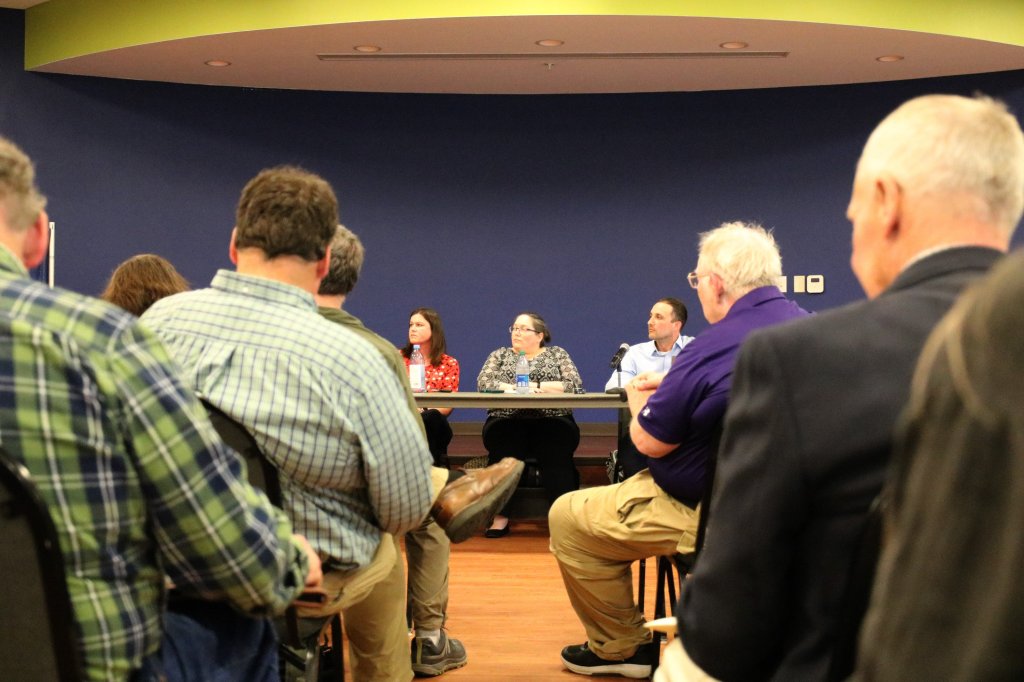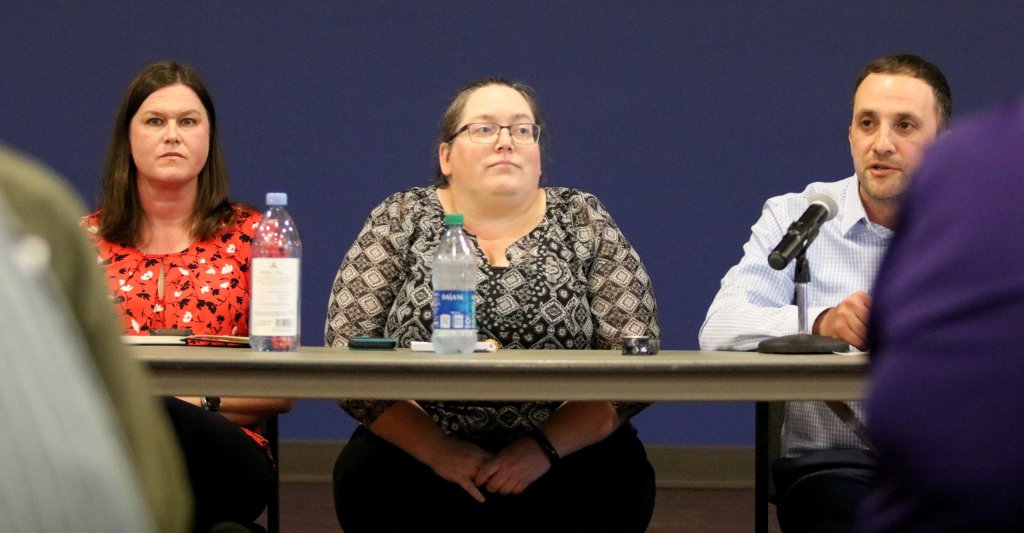WATERVILLE — Todd Martin of Winslow urged federal officials Tuesday night to seriously consider removing the four dams on the Kennebec River, between Waterville and Skowhegan, to restore a healthy river and ensure survival of endangered fish, such as Atlantic salmon.

“The fish lift at Lockwood has been an abject failure,” Martin said of the Waterville dam. “Multiple fish lifts on multiple river dams in a river system has failed everywhere else where it has been tried, including the Merrimack, Saco and Androscoggin rivers. These species need natural river flows to survive, not concrete walls and obstacle courses.”
Martin was speaking to officials from the Federal Energy Regulatory Commission, which hosted a public hearing Tuesday attended by about 80 people at Thomas College in Waterville regarding the draft environmental impact statement FERC released in March.
The statement recommends relicensing the dams and amending the licenses to ensure upstream and downstream access for Atlantic salmon, Atlantic sturgeon, shortnose sturgeon, alewife, blueback herring, American shad, American eel and sea lamprey using fish-passage measures.
FERC is responsible for dam relicensing and, as part of the process, has plans by dam owners Brookfield Renewal Partners to protect the salmon and sturgeon, which are endangered species.
The four dams are the Lockwood Dam and Hydro Kennebec Dam in Waterville, Shawmut Dam in Fairfield and Weston Dam in Skowhegan. Federal licenses are issued for terms of 30 to 50 years.
Martin said he was speaking up for his 5-year-old daughter, Stella, who is learning about local rivers and wildlife. He said he wants to instill in her a deep sense of place, belonging and respect for the land and waters in central Maine.
But Brookfield’s dams are blocking access for Atlantic salmon, Atlantic sturgeon and shortnose sturgeon to get to critical spawning grounds in the Sandy River, Martin said.

Some attendees wore “Reunite the Kennebec River” stickers Tuesday night at the Federal Energy Regulatory Commission public hearing at Thomas College in Waterville. Anna Chadwick/Morning Sentinel
He and many others who attended the hearing said that with the removal of the Edwards Dam in Augusta in 1999 and the Fort Halifax Dam on the Sebasticook River in Winslow in 2008, they saw the immediate rebound of fish species and of the bald eagles, great blue heron, osprey and other wildlife that eat them.
Now, they said, it is time to remove the four upper dams.
“I’ll be 66 the next time these dams come up for relicensing,” Martin said. “Stella will be 35. I dream of the day Stella and I can walk to the banks of the Kennebec River here in Waterville, see a natural flowing river, including the Ticonic Falls, and know that millions of fish are swimming home unimpeded.”
Nick Bennett, staff scientist for the Natural Resources Council of Maine, an environmental advocacy group, told FERC officials the positive changes in the Kennebec have been enormous over the past 30 years.
“The Edwards and Fort Halifax dams came out, (and) the return of life this has brought is one of the great river restoration success stories in the world,” Bennett said. “Sturgeon have returned in much larger numbers in recent years, and are a delight to all who see them.
“The run of alewives up the Sebasticook River has become the largest in the U.S. These fish are a critical food source to every animal that eats fish, and provide a key local source of bait for Maine’s lobster industry. Even seals come into freshwater all the way up to Benton Falls, chasing alewives.”
Bennett asked FERC officials to reconsider an apparent conclusion that the four dams are a significant source of power.
“They are not,” Bennett said.

Elizabeth Moats, seated at left at table, Marybeth Gay and Matt Cutlip, members of the Federal Energy Regulatory Commission, listen Tuesday night to public comments on a proposal to relicense four dams on the Kennebec River, between Waterville and Skowhegan, during a hearing at Thomas College in Waterville. Anna Chadwick/Morning Sentinel
Emma Donovan of Benton, reflecting on an alewife festival held last weekend on the Sebasticook River in her town, said river herring have made a significant recovery since removal of the Edwards Dam. Alewives, she said, provide a great economic benefit to the people and communities that harvest them.
“The income to the town of Benton from the alewife harvest between 2009 and 2022 was $449,562,” she said. “Maine is the only state in the country with a significant alewife harvest, something that was done historically and has only recently become possible again.”
Eliza Townsend, the Maine conservation policy director for the Appalachian Mountain Club, said FERC’s draft environmental impact statement relies on fish-passage measures that have failed on other major rivers. She urged officials to bring all interested parties together to find meaningful solutions that serve the river ecosystem, businesses and communities. Dam removal is worthy of serious consideration, she said.
Townsend said that if FERC issues a license, the Appalachian Mountain Club requests it require the establishment of an $11 million decommissioning fund, bonded into an interest-bearing account, with an escalation clause for regular, additional deposits by the licensee to adjust for cost inflation over the term of the license.
“In the meantime, at a minimum, FERC should require at least two upstream fish lifts at each dam, three-fourths-inch screens on all turbines at each dam and strong performance standards for sea-run species within two years of fish passage construction,” Townsend said.
Jeff Reardon, project manager for the Atlantic Salmon Federation, said FERC’s decisions about fish passage at the four dams would determine whether restoration on the Kennebec River ends at the Lockwood Dam in Waterville and if there is potential to recover salmon there. Dam removal, he said, is the best way to get to restoration.
At least one person expressed concern about removal of hydroelectric dams, saying it is possible to make changes to dams so fish can pass through. W. Elery Keene of Winslow said having electricity is critical for many uses, including lighting and manufacturing.
“I think it’s very important to keep these hydroelectric dams operating,” Keene said, “because we all use so much electricity that we didn’t use a long time ago.”
Another public hearing was held Wednesday morning at the Augusta Civic Center at 76 Community Drive in Augusta.
The public can also comment online until June 4 at ferc.gov/how-file-comment.
Send questions/comments to the editors.








Success. Please wait for the page to reload. If the page does not reload within 5 seconds, please refresh the page.
Enter your email and password to access comments.
Hi, to comment on stories you must . This profile is in addition to your subscription and website login.
Already have a commenting profile? .
Invalid username/password.
Please check your email to confirm and complete your registration.
Only subscribers are eligible to post comments. Please subscribe or login first for digital access. Here’s why.
Use the form below to reset your password. When you've submitted your account email, we will send an email with a reset code.